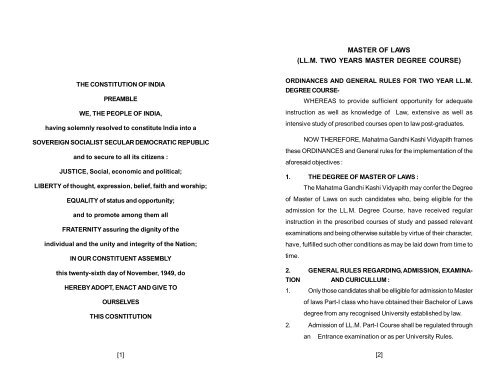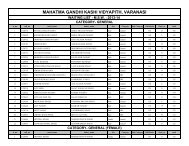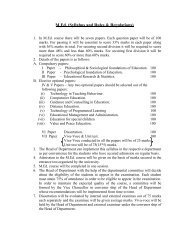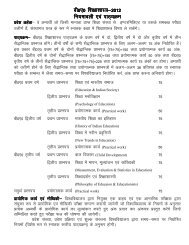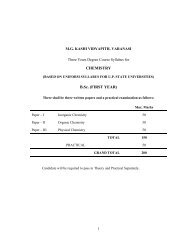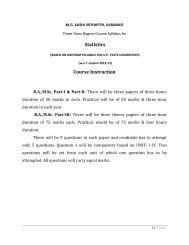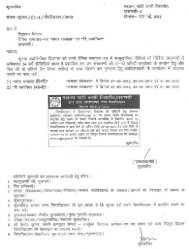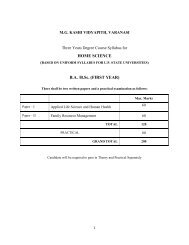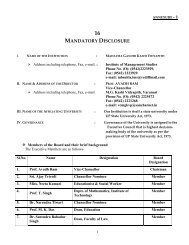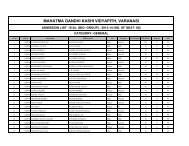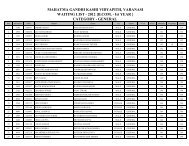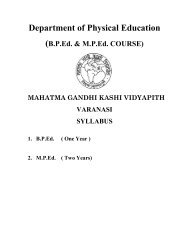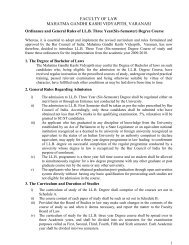master of laws - Mahatma Gandhi Kashi Vidyapith University
master of laws - Mahatma Gandhi Kashi Vidyapith University
master of laws - Mahatma Gandhi Kashi Vidyapith University
- No tags were found...
Create successful ePaper yourself
Turn your PDF publications into a flip-book with our unique Google optimized e-Paper software.
MASTER OF LAWS(LL.M. TWO YEARS MASTER DEGREE COURSE)THE CONSTITUTION OF INDIAPREAMBLEWE, THE PEOPLE OF INDIA,having solemnly resolved to constitute India into aSOVEREIGN SOCIALIST SECULAR DEMOCRATIC REPUBLICand to secure to all its citizens :JUSTICE, Social, economic and political;LIBERTY <strong>of</strong> thought, expression, belief, faith and worship;EQUALITY <strong>of</strong> status and opportunity;and to promote among them allFRATERNITY assuring the dignity <strong>of</strong> theindividual and the unity and integrity <strong>of</strong> the Nation;IN OUR CONSTITUENT ASSEMBLYthis twenty-sixth day <strong>of</strong> November, 1949, doHEREBY ADOPT, ENACT AND GIVE TOOURSELVESTHIS COSNTITUTIONORDINANCES AND GENERAL RULES FOR TWO YEAR LL.M.DEGREE COURSE-WHEREAS to provide sufficient opportunity for adequateinstruction as well as knowledge <strong>of</strong> Law, extensive as well asintensive study <strong>of</strong> prescribed courses open to law post-graduates.NOW THEREFORE, <strong>Mahatma</strong> <strong>Gandhi</strong> <strong>Kashi</strong> <strong>Vidyapith</strong> framesthese ORDINANCES and General rules for the implementation <strong>of</strong> theaforesaid objectives :1. THE DEGREE OF MASTER OF LAWS :The <strong>Mahatma</strong> <strong>Gandhi</strong> <strong>Kashi</strong> <strong>Vidyapith</strong> may confer the Degree<strong>of</strong> Master <strong>of</strong> Laws on such candidates who, being eligible for theadmission for the LL.M. Degree Course, have received regularinstruction in the prescribed courses <strong>of</strong> study and passed relevantexaminations and being otherwise suitable by virtue <strong>of</strong> their character,have, fulfilled such other conditions as may be laid down from time totime.2. GENERAL RULES REGARDING, ADMISSION, EXAMINA-TION AND CURICULLUM :1. Only those candidates shall be elligible for admission to Master<strong>of</strong> <strong>laws</strong> Part-I class who have obtained their Bachelor <strong>of</strong> Lawsdegree from any recognised <strong>University</strong> established by law.2. Admission <strong>of</strong> LL.M. Part-I Course shall be regulated throughanEntrance examination or as per <strong>University</strong> Rules.[1] [2]
3. In order to be eligibel to appear in the Entrance examinationfor admission a candidate has to be Law graduate, providedthat those students who have appeared in the final year examination<strong>of</strong> Bachelor <strong>of</strong> Laws Degree may also appear in theadmisstion Entrance Examination.4. Only those students will be admitted to Master <strong>of</strong> Laws Coursewho qualify in the above examination and are also otherwiseelligible under the admission rules <strong>of</strong> the <strong>University</strong>.5. The division shall be awarded on the basis <strong>of</strong> aggregated marksobtained in LL.M. Part-I and LL.M. Part II examination. A candidatehaving obtained 60 percent or aobve marks shall be placedin First Division and a candidate having obtained 50% or morebut less that 60 percent <strong>of</strong> the aggregate marks at the LL.M.Part-I and LL.M. Part II examination taken together shall beplaced in second division.6. In order to pass in LL.M. Part I or LL.M. Part II Class a studentshall be required to secure at least 40% percent marks in eachpaper separately and an aggregate <strong>of</strong> 50 percent <strong>of</strong> the totalmarks in each part separately.7. In order to be eligible to appear in the examination 75% percentattendance shall be compulsory.8. Only a student having successfully passed LL.M. Part Iexamination shall be eligible for admission in LL.M. Part II class.9. Rules relating to backpaper & improvement are as per<strong>University</strong> rules.COURSE OF LL.M. Part-IMaster <strong>of</strong> Laws degree shall be divided in two parts. There shallbe five compulsory papers in LL.M. Part I class and each paper shallbe <strong>of</strong> 100 marks.Paper I Constitutional LawPaper II JurisprudencePaper IIIPrinciples <strong>of</strong> Legislation and Interpretation <strong>of</strong> StatutesPaper IV Human RightsPaper VLegal Essay (on any <strong>of</strong> the subjects relating to paper I toPaper IV above)COURSE OF LL.M. Part - IIOnly a student having passed LL.M. Part-I examination shallbe admitted to LL.M. Part-II class. A student shall be required toappear in four written papers and one Viva-Voce examination in LL.M.Part-II. One <strong>of</strong> such papers shall be compulsory and the rest threepapers shall belong to any one specialised group <strong>of</strong>fered by a student.Every student will be required to opt for one particular group whichshall consist <strong>of</strong> three papers. Every student shall be examined invivo-voce examination <strong>of</strong> 100 marks. The viva voce examination shallbe based on the papers <strong>of</strong> a specialised group <strong>of</strong>fered by a studentand written assignment submitted by him/her in each paper, there<strong>of</strong>.The student will be compulsorily required to secure at least 40% marksin viva-voce examination separately. The viva-voce examination shallbe conducted by a Board <strong>of</strong> examiners consisting <strong>of</strong> one internal andone external examiners.[3] [4]
6. Freedoms and Social Control : Speech and Expression, media,press and information, contempt <strong>of</strong> court, freedom <strong>of</strong> assembly,association, movement, pr<strong>of</strong>ession, business, property andfreedom to reside and settle.7. Personal Liberty : Rights <strong>of</strong> an accused-double jeopardy-selfincrimination, retroactive punishment; Right to life and personalliberty; preventive detention-constitutional policy.8. Secularism : Concept, Constitutional provision, freedom <strong>of</strong>religion, and state and minority rights.9. Union-State Relations.10. Constitution Process <strong>of</strong> Adaptation and Alteration : Methods<strong>of</strong> constitutional amendment, limitations upon constituentpower, development <strong>of</strong> the Basic structure : Doctrine <strong>of</strong>Judicial Activism and restraint.11. Emergency : Meaning and scope, proclamation <strong>of</strong>emergency-conditions-effect <strong>of</strong> emergency on Union -Staterelations; Emergency and suspension <strong>of</strong> fundamental rights.12. Judiciary Under the Constitution : The Supreme Court andHigh Courts, Judicial review-nature and scope.13. Trade, Commerce and intercourse.Paper - II JURISPRUDENCEMarks : 1001. Definition, nature scope and value <strong>of</strong> Jurisprudence2. Schools <strong>of</strong> Jurisprudence(a) Natural Law(b) Analytical(c) Historical(d) Sociological(e) Realist School(f)Economic Theory.3. Definition <strong>of</strong> Law and its scope4. Soruces <strong>of</strong> Law - (a) Custom (b) Precedent and (c) Legislation5. Administration <strong>of</strong> Justice and Theories <strong>of</strong> Punishment.6. Law and Morality7. Law and Society.8. Concepts <strong>of</strong> Law(a) Right and Duty(b) Legal Person(c) Possession(d) Ownership(e) Property(f)Liability(g) ObligationPaper - III PRINCIPLES OF LEGISLATION ANDINTERPRETATION OF STATUTESMarks : 1001. Principles <strong>of</strong> Legislation : Law making-the legislature,executive and judiciary; Principle <strong>of</strong> utility, Pleasure and paintheory, Asectic principle Relavance <strong>of</strong> John Rawls and RobertNowzick individual interest to community interest, impact <strong>of</strong>these principles upon legislation, distinction.[7] [8]
2. Interpretation <strong>of</strong> Statutes : Meaning <strong>of</strong> term statute,commencment, operation and repeal <strong>of</strong> statutes and purpose<strong>of</strong> interpretation <strong>of</strong> statutes.3. Aids to Interpretation : Internal aids-Title, Preamble, headings,marginal notes, section and subsections, punctuation marks,illustrations exceptions, provisos, saving clauses, schedulesand non obstante clause.External aids : Dictionaries, statutes in para materia,contempornea expositio, debates, inquiry commission reportsand law comission reports.4. Rules <strong>of</strong> Statutory Interpretation : Primary Rules Literal rule,Golden rule, Mischief rule, rule <strong>of</strong> hormonius construction;Secondary Rules-Noscitur a sociis, Ejusdem generis, Reddenosingula singulis.5. Presumption in statutory interpretation : Statutes are valid,statutes are territorial in operation, presumption as tojurisdiction, presumption against what is inconvenient orabsurd, presumption against intending injustice, presumptionagainst impairing obligation or permitting advantage from one'sown wrong, prospective operation <strong>of</strong> statutes.6. Subordinate Principles : Maxims <strong>of</strong> statutory Interpretation :Delegatus non potest delegare, Expressio onius excleusioalterius.7. Principles <strong>of</strong> Constitutional Interpretation : Harmoniousconstruction, Doctrine <strong>of</strong> pith and substance, colourablelegislation, Ancilliary powers, occupied field, Residuary power,Doctrine <strong>of</strong> repugnancy.Paper - IV Human RightsMarks : 1001. Concept - Human Rights2. The United Nations and Human Rights3. (a) Universal Declaration <strong>of</strong> Human Rights(b) International Covenants on Human Rights(c) International convention and Conference on HumanRights.(d) Regional conventions on Human Rights.4. International Covenants and the Indian Constitution.(a) Civil and Political Rights with special reference to PartIII <strong>of</strong> the Indian Constitution.(b) Social and Economic Rights - InternationalInstruments and Part IV <strong>of</strong> the Indian Constitution.5. Human Rights and Vulnerable Groups - Right <strong>of</strong> Women,Children, Disabled, Aged, Tribals and Minorities - National andInternational Legal Development.6. Enforcement <strong>of</strong> Human Rights - International, Regional andNational Machanism.7. Human Rights Commission in Indian.8. International Humanitarian Law9. Refugee Law and Human Rights.10. International Humanitarian Law(a) Protection <strong>of</strong> Defenceless in war(b) Protection <strong>of</strong> wounded, sick and shipwreeked(c) Prisoners <strong>of</strong> war and Human Rights.(d) Status and treatment <strong>of</strong> protected Persons.Paper - V LEGAL ESSAY(On any <strong>of</strong> the topics relating to Paper I to Paper IV above)Marks : 100[9] [10]
LL.M Part-IIPaper-I (Compulsory) RESEARCH METHODOLOGYMarks : 1001. Introduction : Meaning and objective <strong>of</strong> Research, kinds <strong>of</strong>research, Importance <strong>of</strong> Research; Criteria <strong>of</strong> good research,Problems <strong>of</strong> Researchers in India.2. Formulation <strong>of</strong> the Research Problem :Selection <strong>of</strong> the problem, different steps in formulating theproblem; illustrations.3. Research Methodology :Importance <strong>of</strong> Research methodology : procedural guidelinesregarding the research process; defining the researchproblem; survey <strong>of</strong> the literature; working hypothesis;preparation <strong>of</strong> research design; determination <strong>of</strong> sample;design collection <strong>of</strong> data; observation; personal interviews;questionaires and schedules; analysis <strong>of</strong> data; test <strong>of</strong>hypothesis; preparation <strong>of</strong> the report.4. Thesis Writing : Importance <strong>of</strong> Report Writing;(a) Different steps in writing research report; Layout <strong>of</strong>research writing; Preliminary; Main text conclusion andobservation.Mechanics <strong>of</strong> writing a Research Report;Practical Aspect, Physical design; Treatment <strong>of</strong>quotation, Footnotes; Documentation style; Abbreviations;Bibliography, Index etc.Group - ACRIMINAL LAWPaper-I GENERAL PRINCIPLES OF CRIMINAL LAWMarks : 1001. Introduction :(a) Definition <strong>of</strong> Crime(b) Elements <strong>of</strong> Crime(c) Mens rea(d) Crimes <strong>of</strong> Strict Liability(e) Vicarious Liability(f)Joint Liability(g) Principles <strong>of</strong> Legality(h) Protection <strong>of</strong> Life and Liberty2. General Defences : Sections 76-106 IPC(a) Mistake (b) Insanity(c) Intoxication (d) Necessity(e) Accident (f) Infancy(g) Consent (h) Private Defence3. Inchoate Offences :(a) Abetment (b) Conspiracy(c) Attempt.(b)Paper-II CRIMINOLOGY & PENOLOGYMarks : 1001. Definition nature, scope and importance <strong>of</strong> Criminology.2. Methods <strong>of</strong> studies in Criminology.(a) Statistical[11] [12]
(b) Case Study(c) Study <strong>of</strong> the criminal "in the open".(d) Experimental.3. Schools <strong>of</strong> Criminology :(a) Classical(b) Typological(c) Cartographic(d) Sociological(e) Socialist(f)Feminist Approach(g) Multiple Factor Approach.4. Causes <strong>of</strong> Crime :(a) Lombrosian Theory(b) Psycho-analytical Theory(c) Social Disorganisation and Anomie(d) Differential Association Thory(e) Delinquent Sub-Culture Theory.5. Juvenile Delinquency-Causes, prevention & treatment.6. Penology :(a) Theories <strong>of</strong> Punishment(b) Capital Punishment(c) Victimology and compensation to the victims <strong>of</strong> crime.(d) Concept <strong>of</strong> treatment with reference to :(i) Prison(ii) Probation(iii) Parole.Paper-III CRIMES AGAINST SOCIAL AND ECONOMICSECURITY AND PROBLEMS OF THEIR CONTROL.1. Concept <strong>of</strong> Socio-Economic Offences.2. Distinction between Traditional and Socio-Economic Offences.3. White Collar Crime4. Requirement <strong>of</strong> mens rea5. Dowry Prohibition Act, 1961 as amended in 1984, 1986 etc.(i)Definition <strong>of</strong> Dowry(ii) Offence <strong>of</strong> taking/giving dowry and penalities.(iii) Offences <strong>of</strong> Demanding Dowry and Penalities(iv) Dowry to be for the benefit <strong>of</strong> Bride and penalties fornon- transfer <strong>of</strong> Dowry.(v) Agreement for giving and taking Dowry to be void.(vi) Cognizance <strong>of</strong> the Offences.(vii) Offences to be cognizable for certain purposes andnature <strong>of</strong> <strong>of</strong>fences and the act-non-bailable andnon-compoundable.6. Prevention <strong>of</strong> Food Adulteration Act, 1954.(i)Definitions.(ii) Machinary for implementation(iii) Penalties.(iv) Defences available on prosecution.(v) Cognizance and trial <strong>of</strong> <strong>of</strong>fences.[13] [14]
(vi)Application <strong>of</strong> Probation <strong>of</strong> Offenders Act, 1958 andSection 360 <strong>of</strong> Criminal Procedure Code.in trade and wagering agreements.7. Discharge <strong>of</strong> contracts with special reference to the doctrine(vii)Power <strong>of</strong> Central Government to give direction.<strong>of</strong>Frustration.7. Prevention <strong>of</strong> Corruption Act, 1988(i)Offences and penalties8. Implied Contracts.9. Breach <strong>of</strong> contract and Remidies available with special(ii)Appointment <strong>of</strong> special judgesreterence to the general priciples <strong>of</strong> the assessment <strong>of</strong> damages.(iii) Investigation into cases under the Act.(iv) Sanction for prosecution and other miscellaniousprovisions(v) Law relating to Trap(vi) Accomplice8. Offances against SC and ST.Group - BCONTRACT AND INSURANCEPaper -I GENERAL PRINCIPLES OF CONTRACTMarks : 1001. Formation <strong>of</strong> Contract : A critical study <strong>of</strong> <strong>of</strong>fer and acceptance,communication, acceptance and revocation <strong>of</strong> the terms <strong>of</strong><strong>of</strong>fer and acceptance.2. Standard form Contracts.3. Doctrine <strong>of</strong> Consideration and Privity <strong>of</strong> contract, Controversyregarding the abolition <strong>of</strong> consideration.4. Capacity to contract, Nature <strong>of</strong> minor's agreements and thedoctrine <strong>of</strong> restitution.5. Importance <strong>of</strong> Consent : Its existance and absence.6. Public Policy and contractual Agreements relating to restraintPaper- II SPECIFIC CONTRACTMarks : 1001. Contract <strong>of</strong> Agency : Definition, Nature, Creation, Ratification,Rights and Duties, Termination, Liability <strong>of</strong> Principal formisrepresentation and Fraud by agent. Agent's personalliability.2. Contract <strong>of</strong> Indemnitiy : Definition, Characteristic, Contract <strong>of</strong>Insurance as contract <strong>of</strong> Indemnity.3. Contract <strong>of</strong> Guarantee : Definition, Characteristics, Differencebetween indemnity & guarantee, Surety Rights and Liabilities& Discharge <strong>of</strong> Surety.4. Contract <strong>of</strong> Bailment : Defintion, Rights and Liabilities <strong>of</strong> Bailorand Bailee, Lein-General and Particular.5. Contract <strong>of</strong> Pledge : Definition, Difference between Bailmentand Pledge, Rights and Liabilities <strong>of</strong> Pledger and Pledgee.Paper - III INSURANCEMarks : 1001. Nature and definition <strong>of</strong> the Contract <strong>of</strong> Insurance, distinction[15] [16]
etween Life, Fire and Marine Insurance contracts.2. Insurance and Wagering Contracts.3. Insurance interest : Its essentials4. Indemnity as the controlling principle <strong>of</strong> insurance <strong>laws</strong>.5. An insurance contract is a contract <strong>of</strong> Uberrime fidei, i.e. <strong>of</strong>utmost good-faith.6. Doctrine <strong>of</strong> subrogation, its essentials. Surbogation as anecessary corrolary <strong>of</strong> the principle <strong>of</strong> Indemnity.7. Meaning, Scope and Elements <strong>of</strong> Risk, proximate cause underInsurance Contracts.8. Double insurance and Re-insurance.9. Meaning <strong>of</strong> the term "Fire", "Loss <strong>of</strong> Fire", in fire insurancepolicies.10. Meaning, Form, Characters and kinds <strong>of</strong> warranties, effect <strong>of</strong>breach <strong>of</strong> Warranty, Difference between Warranty andRepresentation.11. Nationalisation and Regulation <strong>of</strong> Insurance Business.Group-CBUSINESS ORGANISATIONPaper-I BUSINESS ORGANISATION(Company law excluding Management)Marks : 1001. Company as a legal person, Lifting the veil <strong>of</strong> corportatepersonality.2. Legal position <strong>of</strong> the promoters <strong>of</strong> company, Pre-incorporationcontracts vis-a-vis, promoters.3. Prospectus - Definition, contents and liability in case <strong>of</strong> falserepresentation in the prospectus.4. Memorandum and Articles <strong>of</strong> Association - Contents,Alteration and Legal effects.5. The Object clause <strong>of</strong> Memorandum <strong>of</strong> Association and doctrine<strong>of</strong> ultravires.6. Share Capital, Kinds <strong>of</strong> share Capital : Procedure for increaseand reduction <strong>of</strong> share capital.7. Charge : Floating charge and fixed charge.8. Protection <strong>of</strong> the interests <strong>of</strong> minority share holders.Paper II BUSINESS MANAGEMENT(Company Management & Administration)Marks : 1001. Structure <strong>of</strong> corporate management in India with comparativestudy <strong>of</strong> England and Continental countries.2. Division <strong>of</strong> powers between company in General meeting andBoard <strong>of</strong> Directors.3. Legal position <strong>of</strong> directors and criminal liability <strong>of</strong> the <strong>of</strong>ficers<strong>of</strong> the company.4. Judicial and Administravie remedies in the case <strong>of</strong> mismanagement.5. Appointment, Removal and Remuneration <strong>of</strong> Directors,Managing Director and Manager.6. Secretary <strong>of</strong> the Company : appointment, his qualification,duties and legal position.7. Investigation, Special Audit, Cost Audit.8. Borrowing powers <strong>of</strong> a company and its directors, Effects <strong>of</strong>[17] [18]
doctrine <strong>of</strong> Constructive Notice and Indoor Managment.9. Company Law Board-Compostion and Powers.- Standing Orders and Certification.- Modification <strong>of</strong> Standing orders.- Nature <strong>of</strong> Standing Orders certified under the above Act.Paper- III REGULATION OF LABOUR MANAGEMENTRELATIONSMarks : 1001. Industrial Concepts under the Industiral Disputes Act. 1947.Such as Industry, Workman, Industrial Dispute, Award.2. Reference Machanism <strong>of</strong> disputes under Industrial DisputesAct. 1947.3. Industiral Adjudication under industiral Disputes Act, andCollective Bargaining.4. Regulation <strong>of</strong> Management's Prerogatives during pendency <strong>of</strong>disputes before the authorities under the Industiral DisputesAct. 1947.5. Constitution and functions <strong>of</strong> Industrial Tribunal and LabourCourt and Conciliation Officer.6. Strike and Lock-out :- Concept, Nature and Statutory regulation <strong>of</strong> Strikes andLock-outs.- Right to Strike.7. Arbitration.8. The Trade Union Act, 1926 :- Registration <strong>of</strong> Trade Union and its cancellation.- Rights and Liabilities <strong>of</strong> Trade Unions.- Immunities <strong>of</strong> Trade Unions.9. Industrial Employement (Standing Orders) Act, 1946Group - DADMINISTRATIVE LAWPaper - I ADMINISTRATIVE LAW IN INDIA - IMarks : 100(1) Importance and Scope <strong>of</strong> Administrative Law :(2) Rule <strong>of</strong> Law(3) Separation <strong>of</strong> Powers(4) Delegated Legislation(a) Constitutionality(b) Judicial Control(c) Parliamentary Control(5) Ombudsman in India(6) The Commission <strong>of</strong> Inquiry Act-1952.Paper - II ADMINISTRATIVE LAW IN INDIA - IIMarks : 100(1) Judicial Review <strong>of</strong> Discretionary Power(2) Wirt <strong>of</strong> Mandamus(3) Writ <strong>of</strong> Certioriari(4) Natural Justice; Bias, Opportunity <strong>of</strong> Hearing(5) Administrative Tribunals(6) Domestic Inquiries(7) Adminstrative Finality[19] [20]
(8) Role <strong>of</strong> Declaratory Decree as Public Law Remedy(9) Role <strong>of</strong> Injunction as Public Law Remedy.Paper - III COMPARATIVE ADMINSTRATIVE LAWMarks : 100(1) Merits <strong>of</strong> French Administrative Law; Remedies available underFrench Administrative Law(2) Judicial Control <strong>of</strong> Administrative Discretion in Britain(3) Judicial Control <strong>of</strong> Subordinate Lagislation in Britain(4) Availability <strong>of</strong> Judicial Review in the United States <strong>of</strong> America-(i)Doctrine <strong>of</strong> Primary Jurisdiction,(ii) Doctrine <strong>of</strong> Exhaustion <strong>of</strong> Administrative Remedies,(iii) Doctrine <strong>of</strong> Standing,(iv) Doctrine <strong>of</strong> Ripeness,(5) Governmental liability for torts committed by its employes inBritain, France and India(6) Promissory Estoppel in Britain and India(7) Right to Information -(a) State Privilege to Refuse Production <strong>of</strong> documents inCourts in Britain and India(b) The Official Secrets Act, 1923 (India)(c) Right To Information Act., 2005[21]


